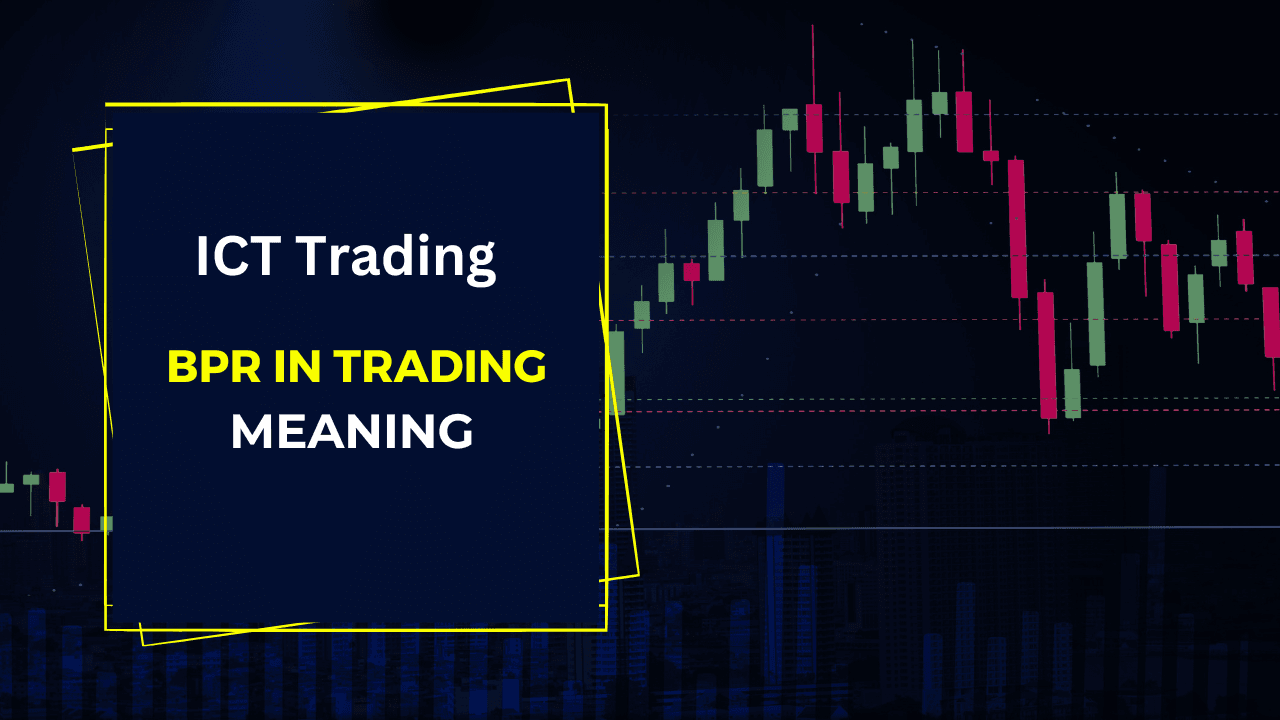The Balanced Price Range (BPR) is a crucial concept in ICT (Inner Circle Trading), representing a period where the market finds equilibrium between buyers and sellers. Understanding how price reacts within a BPR zone allows traders to predict potential price moves and make more informed decisions. In this article, we will delve into the meaning of BPR in trading, BPR in trading meaning how it works within ICT strategies, and how you can effectively use it to improve your trade setups. Mastering BPR can help you identify key market turning points and gain a competitive edge in the market.
Introduction to BPR in Trading
What is BPR in Trading?
The Balanced Price Range (BPR) is a key concept in ICT (Inner Circle Trading) that describes a range within which the price moves back and forth between two levels, showing equilibrium between the market’s buyers and sellers. Within this range, the price tends to oscillate rather than make sharp upward or downward movements, as neither the buying side nor the selling side has enough strength to break the range definitively.
Understanding what BPR means in trading is essential because it allows traders to recognize periods where the market is consolidating or preparing for a breakout. BPR in ICT specifically helps traders anticipate where price might head next once the range breaks, making it an important tool for trade decision-making.
Origins of the Concept in ICT
The concept of BPR is rooted in ICT (Inner Circle Trading) teachings, a methodology that focuses on market mechanics and liquidity. ICT emphasizes understanding market structures like Balanced Price Ranges to identify where institutional players might step in and influence price movement. BPR trading revolves around identifying these ranges to anticipate future price shifts based on historical patterns.
For those following ICT strategies, recognizing a Balanced Price Range provides a unique advantage. It helps traders avoid false breakouts and time their entries and exits with greater precision.
Importance of Understanding BPR in Trading
For traders, understanding the Balanced Price Range is crucial because it offers insight into where the market might pause, reverse, or continue. The market often consolidates before making significant moves, and recognizing a BPR zone enables traders to anticipate future trends. By identifying where the market reaches equilibrium, traders can minimize risk by placing trades when the price is more likely to behave predictably.
In short, mastering BPR in trading offers traders a window into the market’s intention, providing valuable clues about potential breakouts or retracements.
How BPR Works in ICT Trading
ICT Perspective on BPR
From an ICT (Inner Circle Trading) standpoint, BPR is all about understanding equilibrium in the market. When a price moves within a Balanced Price Range, it’s essentially oscillating between two key levels where neither buyers nor sellers have a decisive advantage. This creates a temporary balance, and traders can exploit this phase by waiting for the eventual breakout or breakdown from the range.
In ICT trading, recognizing a BPR involves carefully analyzing historical price data to see where the market has consistently moved between certain high and low levels. This helps identify zones of liquidity where larger market participants may act, pushing prices sharply once a breakout occurs.
Price Movement in a Balanced Price Range
The way price moves within a BPR zone can reveal much about future market behavior. Price typically moves in a sideways fashion within the BPR, repeatedly testing the upper and lower boundaries of the range. Traders often use these points as entry and exit levels, anticipating that price will eventually break free from the range, offering a profitable trading opportunity.
The middle point, or equilibrium, of the Balanced Price Range is particularly important because it represents the balance between buying and selling pressure. ICT traders often watch this midpoint closely to gauge when the market might be ready to break out of the BPR and initiate a strong directional move.
When the price finally breaks out of the BPR zone, it often signals a shift in market sentiment, where one side gains control, pushing the price either upward or downward with greater momentum. Traders who have identified this range early can benefit from strong moves after the breakout.
Key Components of BPR in Trading
Defining the Range
To effectively utilize Balanced Price Range (BPR) in trading, it’s essential first to define the range accurately. A BPR is characterized by two main levels: the upper boundary and the lower boundary. The upper boundary represents the highest price level within the range, while the lower boundary signifies the lowest price level.
Identifying these boundaries involves analyzing historical price action to find consistent highs and lows where the price has frequently reversed. Traders can use various charting tools, such as horizontal lines or rectangles, to visually mark these boundaries on their charts.
Understanding the dynamics within this range is critical. Price tends to fluctuate between these levels, creating opportunities for traders to capitalize on small movements. By knowing where the upper and lower boundaries lie, traders can set buy and sell orders accordingly, increasing their chances of entering profitable trades.
Middle or Equilibrium Point
The middle point of the Balanced Price Range is often referred to as the equilibrium point. This is a critical component for traders as it represents the balance between buying and selling pressures. When price approaches this midpoint, it often indicates a potential reversal point or continuation of the existing trend.
Traders watch the equilibrium closely because it can act as a strong support or resistance level. If the price approaches the middle point and bounces off, it can signal an opportunity to buy or sell, depending on the direction of the bounce. Conversely, if the price breaks through this midpoint, it can indicate a shift in market sentiment, prompting traders to adjust their strategies accordingly.
Understanding the significance of the equilibrium point allows traders to gauge when the market may be preparing for a breakout or breakdown. This insight can enhance decision-making, making it easier to determine when to enter or exit trades.
How to Use BPR in Trading
Steps to Apply BPR in ICT Strategy
To successfully use BPR in trading, particularly within the context of ICT (Inner Circle Trading), follow these steps:
- Identify the BPR Zone: Start by analyzing price charts to pinpoint the upper and lower boundaries of the BPR. Use historical data to find where price has consistently bounced back and forth.
- Draw the BPR on Your Chart: Use horizontal lines or rectangles to mark the boundaries and the equilibrium point on your trading chart. This visual representation will help you see where price is likely to react.
- Monitor Price Movement: Watch how the price behaves as it approaches the BPR boundaries. Look for signs of rejection, such as long wicks or pin bars, which can indicate potential reversals.
- Set Your Trade Triggers: Based on your observations, set buy or sell orders near the boundaries of the BPR. Ensure you have defined your risk management strategies, such as stop-loss placements.
- Evaluate Breakouts: If the price breaks out of the BPR, assess whether it’s a valid breakout or a false signal. Look for confirmation through volume or price action before entering a trade in the breakout direction.
- Adjust Your Strategy: If the price breaks through the BPR and moves in the anticipated direction, consider adjusting your strategy accordingly. Use the new price levels to redefine your boundaries for future trades.
By following these steps, traders can effectively integrate BPR into their ICT trading strategies, enhancing their chances of successful trades.
Examples of BPR Trades
To better understand how to apply BPR in trading, here are a couple of practical examples:
- Example 1: Suppose you identify a BPR between $50 and $55 on a stock chart. As the price approaches $50, you observe a rejection candle, indicating strong buying interest. You could place a buy order slightly above $50, with a stop-loss just below the lower boundary. If the price bounces back, you can profit as it moves back toward the upper boundary.
- Example 2: Imagine a BPR for a currency pair between 1.2000 and 1.2050. As the price nears 1.2050, you see signs of selling pressure and long wicks. You could enter a short trade at 1.2045, with a stop-loss above the upper boundary. If the price breaks down and moves toward 1.2000, you can secure profits from the trade.
These examples illustrate how recognizing and using BPR can lead to informed trading decisions and successful outcomes.
Common Mistakes to Avoid
While using BPR in trading, it’s important to avoid common pitfalls:
- Misidentifying Boundaries: Ensure you accurately identify the upper and lower boundaries of the BPR. Misinterpretation can lead to poor trading decisions.
- Ignoring Volume: Pay attention to trading volume during breakouts. Low volume can indicate a weak breakout that may reverse.
- Not Using Stop-Losses: Always incorporate risk management strategies, including stop-loss orders, to protect your capital in case the trade goes against you.
By being aware of these potential mistakes, traders can enhance their BPR trading strategies and increase their overall effectiveness in the market.
The Role of BPR in Market Structure
Understanding Market Structure
The Balanced Price Range (BPR) plays a significant role in the overall market structure, acting as a foundational element for analyzing price behavior and market dynamics. In trading, market structure refers to the organization of price movements over time, including trends, support and resistance levels, and consolidation patterns.
When traders understand BPR, they can better recognize the stages of market movement. A BPR indicates a period of consolidation, where the price oscillates between defined levels, suggesting that the market is in a state of indecision. During this time, traders can analyze the balance between buying and selling forces, which can signal potential future price movements.
By incorporating BPR into their market structure analysis, traders can identify critical levels where the price may react, providing valuable insights for making informed trading decisions. Understanding how the BPR fits into the broader market context enhances a trader’s ability to predict future price action, whether it’s a breakout, reversal, or continuation.
Identifying Market Sentiment with BPR
The BPR also helps traders gauge market sentiment. When the price is contained within a BPR, it suggests that the market participants are uncertain about the future direction. This uncertainty can lead to decreased volatility, making it a prime opportunity for traders to observe potential entry and exit points.
For example, if the price consistently tests the upper boundary of a BPR but fails to break out, it might indicate that sellers are gaining strength. Conversely, repeated tests of the lower boundary without a breakdown could signal that buyers are ready to take control.
By using the BPR as a tool for understanding market sentiment, traders can align their strategies with the prevailing market conditions, enhancing their chances of success. This alignment is critical, as trading against the market sentiment often leads to unfavorable outcomes.
Advantages of Using BPR in Trading
Enhanced Trade Timing
One of the primary advantages of using BPR in trading is improved trade timing. By understanding where the price is likely to react within the BPR, traders can make more strategic decisions about when to enter or exit trades. This ability to time trades accurately can significantly enhance profitability.
For instance, by identifying the upper and lower boundaries of the BPR, traders can place orders to capitalize on price fluctuations. If the price approaches the upper boundary and shows signs of rejection, a trader might sell, anticipating a reversal. Conversely, a price bounce off the lower boundary can signal a buying opportunity. This proactive approach allows traders to catch movements early, maximizing potential gains.
Risk Management and Protection
Using BPR also strengthens a trader’s risk management strategy. By clearly defining the upper and lower boundaries, traders can set logical stop-loss orders. This means that if the price breaks out of the BPR unexpectedly, the trader can limit their losses effectively.
For example, if a trader buys at the lower boundary of a BPR with a stop-loss just below that level, they can protect themselves from significant losses if the market moves against them. This systematic approach to risk management is essential for maintaining a sustainable trading practice.
Flexibility Across Markets
Another advantage of employing BPR in trading is its flexibility across various markets, including stocks, forex, commodities, and cryptocurrencies. Regardless of the asset class, the principles of BPR remain applicable, making it a versatile tool for traders of all levels.
Traders can apply the same strategies for identifying and using BPR in different markets, adapting their techniques based on the specific characteristics of each asset. This adaptability allows traders to diversify their portfolios and apply their understanding of BPR in various trading scenarios.
Improved Market Insight
Lastly, utilizing BPR can lead to improved market insight. By analyzing price movements within a BPR, traders can develop a better understanding of the market’s overall behavior. This insight can inform future trading strategies and enhance a trader’s ability to read the market effectively.
Recognizing patterns within the BPR can help traders anticipate future price movements based on historical behavior, enabling them to make well-informed decisions. This analytical approach helps traders develop a more intuitive understanding of market dynamics, leading to more successful trading outcomes.
Common Misconceptions About BPR in Trading
BPR is Only for Day Trading
One of the most prevalent misconceptions about Balanced Price Range (BPR) is that it is only applicable for day trading. Many traders believe that since BPR focuses on short-term price movements within defined levels, it’s only suitable for those looking to capitalize on intraday fluctuations. However, this notion is misleading.
BPR can be effectively utilized across various trading styles, including swing trading and position trading. For example, swing traders can use BPR to identify potential reversal points over several days or weeks, while position traders may look at longer-term BPRs to make strategic decisions based on broader market trends. The versatility of BPR makes it a valuable tool for all types of traders, not just those engaging in quick, intraday trades.
BPR Guarantees Profits
Another common misconception is that using BPR guarantees profits in trading. While understanding BPR can enhance decision-making and improve trade timing, it does not eliminate the inherent risks associated with trading.
Traders often fall into the trap of believing that if they identify a BPR correctly, they are assured of successful trades. In reality, market conditions can change rapidly, and factors such as news events, economic indicators, and market sentiment can impact price movements unpredictably. Therefore, while BPR can provide insights and improve trading strategies, it should always be used in conjunction with effective risk management practices.
BPR is Complex and Difficult to Understand
Many traders, especially beginners, perceive BPR as a complex concept that requires advanced knowledge and skills to implement effectively. This belief can deter aspiring traders from utilizing BPR in their trading strategies. However, this notion is not entirely accurate.
In reality, understanding and applying BPR can be relatively straightforward. With practice, traders can learn to identify BPRs and interpret price movements within these ranges. Numerous educational resources, such as online tutorials, webinars, and trading communities, are available to help traders grasp the concept and effectively apply it in their trading.
BPR is Only About Support and Resistance
Another misconception is that BPR solely revolves around identifying support and resistance levels. While these components are integral to the BPR concept, it encompasses much more.
BPR also includes understanding market sentiment, identifying potential reversals, and recognizing the overall market structure. It allows traders to analyze how price interacts with defined boundaries and provides insights into market psychology. Thus, limiting BPR to just support and resistance levels can lead to a narrow understanding of its potential applications in trading.
Conclusion
In conclusion, the Balanced Price Range (BPR) is a powerful tool in trading, providing valuable insights into market structure, sentiment, and potential trade opportunities. By understanding the key components of BPR and how it fits into ICT (Inner Circle Trading) strategies, traders can enhance their decision-making process and improve their overall trading performance.
While there are common misconceptions about BPR, such as its applicability only to day trading or the belief that it guarantees profits, it is essential to recognize that BPR is versatile and can be adapted to various trading styles. Furthermore, it is not a complex concept but rather an accessible tool that can significantly benefit traders when applied correctly.
Ultimately, integrating BPR into your trading strategy can lead to better trade timing, enhanced risk management, and improved market insight. By avoiding misconceptions and understanding the true nature of BPR, traders can navigate the complexities of the market with greater confidence and success.
Read More What Is a Breaker Block in Trading?
Frequently Asked Questions
What does BPR stand for in trading?
BPR stands for Balanced Price Range. It refers to a specific price zone where the market exhibits a period of consolidation, oscillating between defined support and resistance levels. Understanding BPR helps traders identify potential entry and exit points within this range.
How do I identify a BPR in the market?
To identify a BPR, traders should look for areas on a price chart where the price consistently bounces between upper and lower boundaries over a period. These boundaries are often identified as support and resistance levels. Once established, traders can analyze price movements within this range for trading opportunities.
How does BPR relate to market sentiment?
BPR helps traders gauge market sentiment by indicating periods of consolidation. A tight BPR suggests uncertainty among market participants, while breakouts from a BPR may signal a shift in sentiment, providing insights into potential future price movements.
Can BPR be used in all types of trading?
Yes, BPR can be utilized across various trading styles, including day trading, swing trading, and position trading. Its principles are adaptable, making it a valuable tool for traders regardless of their preferred trading approach.


